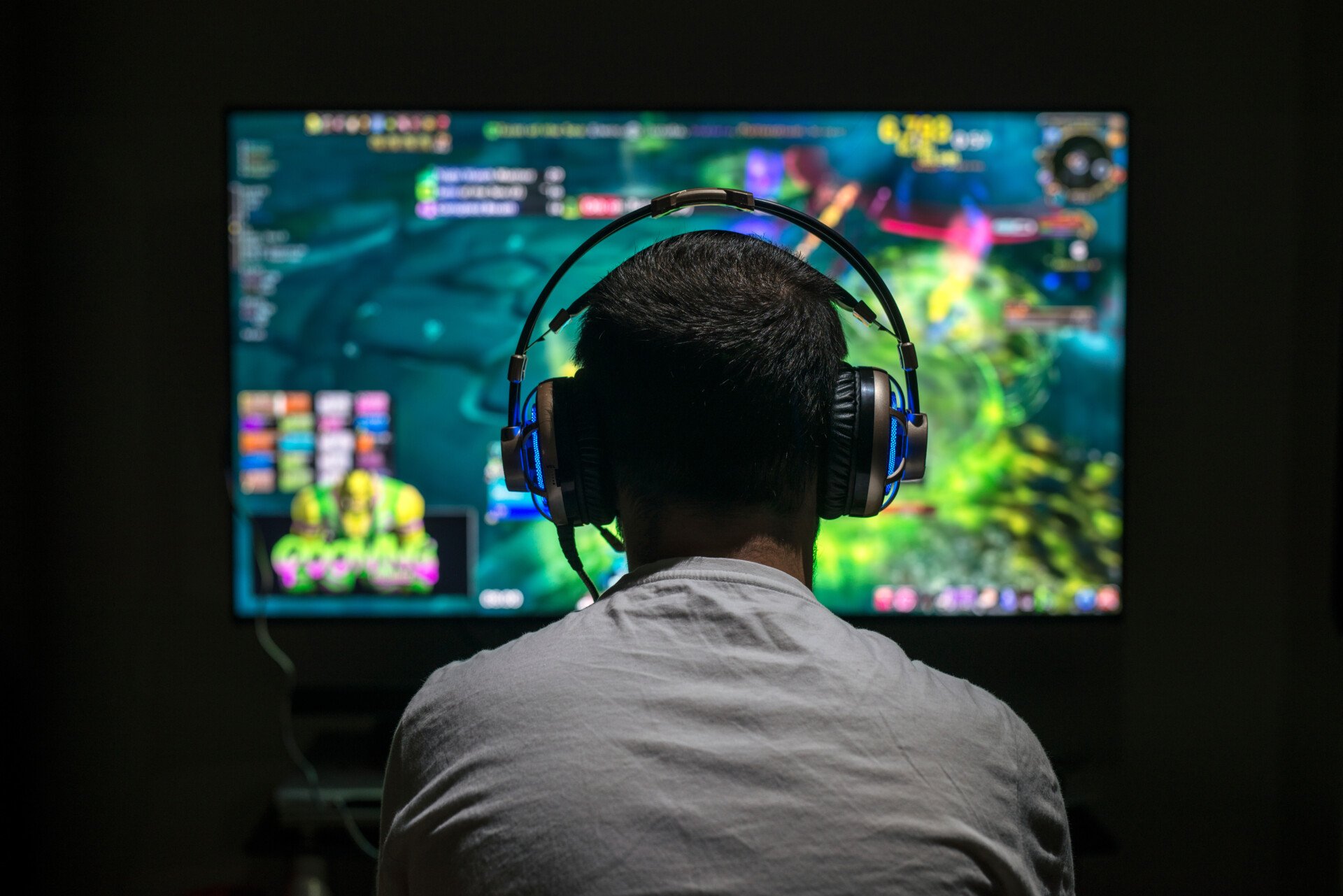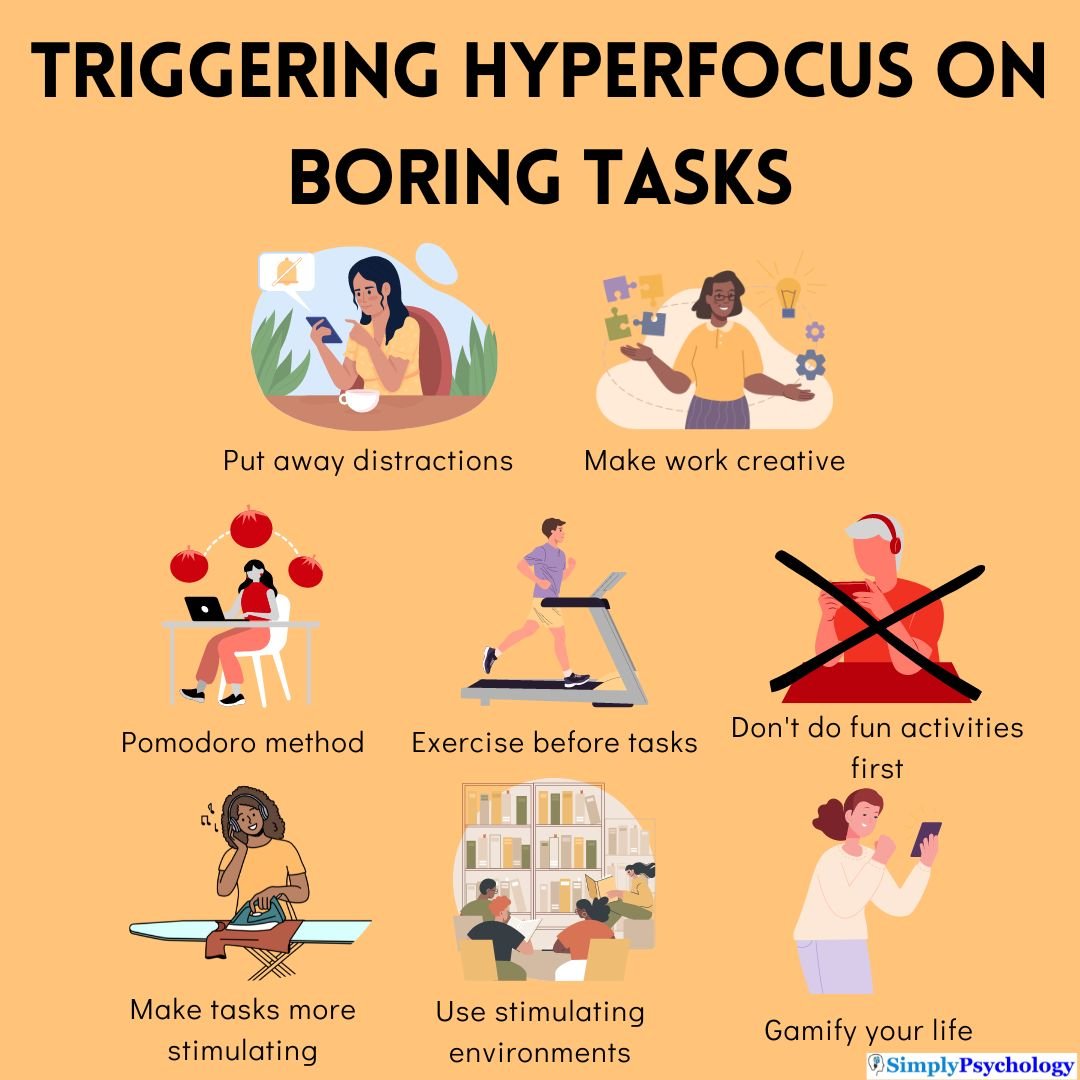Hyperfocus is a common sign of ADHD that refers to the intense concentration that some people with ADHD experience when engaged in activities they enjoy.
It is characterized by deep absorption in an activity for extended periods, to the exclusion of external stimuli.
While hyperfocus can boost productivity, it can also lead to neglect of responsibilities. It contrasts with the distractibility more commonly associated with ADHD.

Signs and Characteristics of Hyperfocus
Hyperfocus in ADHD is the opposite of distractibility and is common among both children and adults with ADHD. Key signs and characteristics include:
- Deep absorption in an activity, leading to diminished awareness of external stimuli.
- Difficulty noticing or responding when someone is speaking.
- Dysregulated attention, showing extreme attention to some tasks and difficulty paying attention to others.
- Experiencing “time blindness,” losing track of how much time has passed.
- Inability to easily shift attention away from tasks that are highly engaging.
- Enhanced task performance during periods of hyperfocus.
- Significant energy required to begin a task, with momentum increasing once hyperfocus is achieved.
- Devoting a lot of time, attention, and affection to a new romantic partner.
Many people have described this ADHD hyperfocus as falling under ‘hypnotic spells’ as they become immersed in an activity (Brown, 2005)
James finds it difficult to focus during conversations that he has with his parents. He often gets very distracted and cannot get through a household chore without losing interest and doing something else. However, James can be very engaged in video games for hours at a time, to the extent that he often loses track of time. Not much can draw his focus away from the game. James' dad is confused and exclaims to James, "You can pay attention when you want to!"
“It seems to be specifically used around instances of activities that are highly engaging, interesting, rewarding to the individual and is far less likely to occur when there are tasks that are boring, unrewarding, uninteresting.”
Dr. Russell Barkley, Clinical Neuropsychologist
Why hyperfocus occurs in aDHD
The brain’s role
Like distractibility, hyperfocus is thought to result from abnormally low levels of dopamine in the brain (Wu et al., 2012).
Dopamine drives motivation and reward; its deficiency in ADHD complicates shifting from engaging to mundane tasks. This dopamine deficiency can make it hard to shift from interesting tasks to more uninteresting tasks.
This is because the brains of people with ADHD are drawn to activities that give them instant rewards, such as video games, TV shows, and other activities they may find enjoyable.
There is significant evidence from brain imaging studies that demonstrate increased prefrontal activity when hyperfocused attention is in use (Sklar, 2013).
Instant feedback
Activities such as video games provide instant feedback. Feedback is a response from the environment as a result of a person’s action.
Everyone can benefit from instant feedback, but those with ADHD thrive from it and will keep seeking feedback in order to get that dopamine hit.
Intrinsically motivating tasks
Those with ADHD will usually hyperfocus on an activity that they are intrinsically motivated towards. Intrinsic motivation means that someone engages in an activity because they get pleasure from the activity itself rather than being motivated by external factors.
People with ADHD may have greater difficulty focusing on tasks that are not intrinsically rewarding (Kauffman et al., 2000).
For something to be intrinsically motivating, an activity may require the following:
- A clear goal to work towards
- Visible progress toward reaching that goal
- Clear and immediate feedback
- A balance of challenge and skill
‘because I think the energy that the ADHD brain seems to have….it’s unfocused, quite scattered, chaotic and a bit random…but give that brain something that really you can tune into and it’s your interest, then all that random stuff just goes boom… I get this incredible intense concentration and that’s great for work….’
Interview extract from Sedgwick et al. (2019)
Positive effects of Hyperfocus
If someone with ADHD is able to tap into their hyperfocus abilities, it can provide many strengths:
- Increased productivity: Hyperfocus significantly boosts productivity by enabling deep concentration on tasks such as work projects.
- Enhanced sense of accomplishment: Successfully achieving goals during hyperfocus sessions strengthens self-confidence and self-esteem.
- Career advancement: Strategic use of hyperfocus can facilitate career success, particularly in fields like science, writing, and the arts, where sustained focus is beneficial.
- Improved deadline management: Hyperfocus allows individuals with ADHD to effectively meet tight deadlines by dedicating complete attention to critical tasks.
- Rapid skill acquisition: Sustained attention through hyperfocus can accelerate the learning of new skills, such as languages or musical instruments.
- Faster task completion: Tasks can be accomplished more quickly due to intense focus.
- Enhanced skill refinement: Hyperfocus provides dedicated time for practice and skill improvement.

“because I think the energy that the ADHD brain seems to have….it’s unfocused, quite scattered, chaotic and a bit random…but give that brain something that really you can tune into and it’s your interest, then all that random stuff just goes boom… I get this incredible intense concentration and that’s great for work….”
From Sedgwick et al. (2019).
‘…I think if you can learn how to harness it… if you can tap into the energy and direct it…if you can learn how to control and direct it and focus it on the right things, then the positives have huge potential…. huge…huge potential…’
Interview extract from Sedgwick et al. (2019)
Negative effects Of Hyperfocus
While there are some benefits that can come from hyperfocus, if it is not managed properly, it can cause many problems:
- Neglected responsibilities: Hyperfocus may lead to neglecting important responsibilities like school assignments or work tasks, resulting in missed deadlines.
- Uneven performance: When hyperfocus is limited to enjoyable tasks, performance in less engaging areas at work or school can significantly suffer.
- Poor work-life balance: Extended periods of hyperfocus can result in overworking, leading to stress and burnout.
- Strained relationships: Partners or family members may feel ignored or frustrated due to the individual’s intense focus on specific activities.
- Lack of time management: Hyperfocusing on select tasks might leave insufficient time for other essential duties, causing feelings of being rushed or unprepared.
- Increased self-criticism: Individuals may become critical of themselves when they cannot replicate the same level of focus on less enjoyable tasks.
- Neglect of personal care: Extended hyperfocus sessions can cause neglect of personal needs, including eating, hydration, or basic hygiene.
“There’s always the temptation to work, it’s always there. Sometimes some guilt associated with not working if you feel like there’s something to be done and there’s always something that could be done.”
Dr. Randall Duthler
“I’m like, oh, I’ll just look at this for five minutes and then 45 minutes go by or an hour, and why did I research more author, why did I research whatever? It’s an hour and a half or more digging into something you weren’t supposed to.”
From Ginapp et al. (2023).
“There’ve been countless times I forgot to eat, I won’t hydrate, I won’t go to the bathroom.”
From Ginapp et al. (2023).
What are hyperfixations in ADHD?
Hyperfixations often coincide with hyperfocus, greatly impacting productivity.
During a hyperfocus session, a person with ADHD might become deeply engrossed in their hyperfixation topic or activity. For example:
- Spending hours researching every detail about a specific historical event
- Coding non-stop to develop a new feature for a personal project
- Creating extensive, detailed artwork related to a favorite fictional universe
These sessions can be incredibly productive, allowing individuals to make significant progress in their areas of interest. The combination of hyperfixation and hyperfocus can lead to:
- Rapid skill development in specific areas
- Creation of complex, detailed work
- Deep, comprehensive understanding of niche subjects
How to hyperfocus with aDHD
There may be some ways in which hyperfocus can be used to your advantage if you need to complete boring tasks:
Put away distractions
If you have a work or school assignment to complete and you know you are likely to be distracted, remove the distractions.
This could include putting your phone in another room or switching it off and blocking certain distracting websites on your computer until your work is complete.
“It’s important to take stock, especially if there’s a task that you struggle with – what do you find yourself deviating towards and remove that stimulus.”
Mickey Atkins, Therapist and Social Worker.
Distractions can be different for each person – what one person may find distracting may not be distracting for someone else.
For example, many neurotypicals may find it distracting to work with a podcast or video playing in the background, but someone with ADHD may find that this extra stimulation helps them work through their less engaging tasks.
Make work creative
Injecting creativity into mundane tasks can make them more engaging and conducive to hyperfocus. Think about how you can transform boring work into something more dynamic that taps into your interests.
For example:
- Draw diagrams, charts, and illustrations to visualize concepts instead of just writing paragraphs.
- Reimagine a paper you’re writing as a play, movie pitch, or comic book.
- Use colorful pens, highlighters, and fonts to add visual interest to worksheets.
- In a presentation, integrate multimedia like videos, animations, and interactive elements.
- When problem-solving, act out scenarios physically or use props if helpful.
- Weave personal stories and examples into your work to engage yourself.

Pomodoro method
This is a technique that is commonly used for studying. It involves dedicating a certain amount of time to focusing on work, followed by a short break.
For instance, you can set a timer for 25 minutes, during which you only spend that time on your task (e.g., on homework or chores), and then when the timer goes off, you have a 5-minute break. After this break, set another 25-minute timer, and so on.
There are plenty of Pomodoro videos on YouTube with different themes and background music to make your focus time more interesting. In this way, you don’t need to remember to keep setting reminders – just press play, and the video will guide you.
“Generally, when in clinical intervention, what we see is that, especially for folks with inattention, being realistic about the amount of time that we can devote to one particular thing is very very important.”
Mickey Atkins, Therapist and Social Worker.
Exercise before tasks
Engaging in physical activity before sitting down to work can be an effective way to trigger hyperfocus. Exercise releases dopamine and other neurotransmitters that boost motivation, focus, and attention.
Try incorporating movement into your pre-task routine:
- Go for a 15-30 minute walk or jog to get your heart rate up. Aerobic exercise that elevates your breathing can be especially beneficial.
- Do a brief HIIT workout – alternate short bursts of intense activity with rest periods. Jumping jacks, squats and lunges are options.
- Dance to some lively music to get energy flowing before starting tasks.
- Stretch thoroughly after warming up muscles. This promotes blood flow to the brain.
The key is choosing physical activities you enjoy and look forward to. Stay hydrated afterward. A mini-workout can optimize your mental state for hyperfocus.
Don’t do fun activities first
It can be hard for someone with ADHD to switch out of doing fun activities once they have started, and this can also trigger hyperfocus on the fun task.
Instead, try to complete your other, less exciting tasks for the day first, and then the enjoyable activity can be used as a reward for whatever time is left in the day.
Also, try not to force yourself to complete all of your boring tasks in one go.
For example, if you know there are a lot of dishes to wash in the sink, trying to complete this chore can feel overwhelming.
Give yourself permission to just wash what you need at that time. Or, set yourself a two-minute timer and try to wash as much as you can in that time. Once the timer is finished, you can walk away.
Gamify your life
Gamification is the application of adding game-like elements to non-game contexts to encourage participation.
Since games are a popular hyperfocus activity for people with ADHD, gamifying tasks can make them more enjoyable and could trigger hyperfocus (Sújar, 2022).
For instance, there are many phone apps that are formatted as a game but help users focus on their goals and productivity in real life, such as apps that can turn your mundane tasks into quests with rewards.
Create an optimally stimulating environment
The environment you are in can have a big impact on your ability to focus and enter a state of hyperfocus.
For some, a busy coffee shop with a moderate buzz of chatter and activity can hit the sweet spot. For others, near-silence in a library study room is best. Experiment to find what works for you.
- Play instrumental or lyric-less music (like lofi hip-hop beats) in the background at a moderate volume.
- Add ambient nature sounds like rain or ocean waves using a sound machine or phone app.
- Keep fidget toys within reach to occupy your hands while you work. Fidget cubes, spinners, and squishy stress balls can help.
- Change up your location throughout the day – move between a desk, couch, floor, or table. Variety can help sustain interest.
- Diffuse essential oils like peppermint, which may promote focus.
Experiment to find the optimal level of sensory stimulation that triggers your hyperfocus zone. Tweak the sights, sounds, textures, and smells around you to dial in an environment that engages you fully.
How to manage your hyperfocus time
If you find that you want to break out of a hyperfocused state, especially if it is negatively affecting your other responsibilities, there are some ways in which this could be achieved.
Note that not every tactic will work for everyone in all situations. If you are continuously trying the same tactic and it is not working, then that is probably not the right method for you.
Identify hyperfocus triggers
A good place to start is to be aware of what your hyperfocus triggers are. These will often be activities that are intrinsically enjoyable for you.
Here are some tips for identifying your unique hyperfocus triggers:
- Observe when during the day you tend to hyperfocus most, and capitalize on those natural productive times.
- Talk to friends/family to get an outside perspective on what activities you seem most focused on. Others may notice your patterns better than you do.
- Experiment purposefully with different environments, tools, stimuli, and framing of tasks to pinpoint exactly what draws you in. The more you actively test variables, the faster you’ll learn your triggers.
Timers
Setting aside a certain amount of time for hyperfocus activities and then arranging a timer to go off at the end is a good indicator that it is time to stop and move on to something else.
Setting multiple timers to go off every few minutes can also be useful if you find you may ignore the first one.
It could also be beneficial to have a visual timer directly in front of you so that you can actually see the time in your environment.
Schedule the day
Come up with two or three reasonable tasks for the day that needs to be done. Aim to get these done first before moving on to other tasks, which can cause hyperfocus.
It may be helpful to also schedule each hour of the day dedicated to working on a specific task. Once the hour is over, it is time to move on to the next item on the schedule.
This can also be helpful if you are someone who hyperfocuses on work and is neglecting other responsibilities due to overworking:
“Be more fragmented about your time and schedule to block out times that you work and be really regimented about carving out some personal time or family time.”
Dr. Randall Duthler
Ask someone to distract you
If you struggle to end hyperfocus tasks by yourself, don’t be afraid to reach out to someone to help you.
You could arrange with a friend or partner to distract you at a time when you wish to stop your hyperfocus activity.
At work, this could involve asking a co-worker to send you an email as a reminder to move on to another task.
“I’ve learned to have other people kind of let me know when it’s time to move on.”
Jessica, from @HowToADHD
Schedule hyperfocus activities
If you need to be somewhere during the day, such as an appointment or work meeting, don’t start a hyperfocus activity just before.
Also, try not to do this hyperfocus activity before going to bed, as you may find it hard to stop, and this can disrupt sleep.
Instead, you could schedule a time when you can allow yourself to hyperfocus, such as a day when you have no other responsibilities or after you have completed all you planned to do that day.
This can also help to alleviate some of the shame or guilt that may arise from hyperfocusing for long periods of time.
As long as you can look back on your day and see that you have achieved what you set out to achieve, then allow yourself permission to enjoy yourself!
FAQs
What is a hyperfocus hangover?
When coming out of hyperfocus, it can often leave you feeling drained, as if you have a hangover. You may experience some of the following symptoms:
– Being unaware of what time it is
– Feel thirsty as if you haven’t drunk for days
– Feel hungry and cannot recall when you last ate
– Feel as though you haven’t been breathing properly for hours and need to take some deep breaths
– Feel overstimulated, as if the lights in the room are too bright
– Feel as if you have overindulged in an activity for a very long time
– The desperate need to urinate that wasn’t noticed before
Can people without ADHD hyperfocus?
A study found that people with ADHD experienced hyperfocus more often than neurotypical individuals, both in general and across a range of specific settings (Hupfield et al., 2019).
However, it is common for anybody to get lost in something that interests them or get into a flow of work. A lot of neurotypical people would likely report experiencing a hyperfocus-like state at some point in their lives.
What is the difference between hyperfocus in ADHD and intense focus in neurotypicals?
While neurotypicals can experience periods of intense focus on tasks they find interesting or meaningful, individuals with ADHD tend to hyperfocus involuntarily on tasks regardless of interest level.
References
Ashinoff, B. K., & Abu-Akel, A. (2021). Hyperfocus: The forgotten frontier of attention. Psychological Research, 85(1), 1-19.
Ayers-Glassey, S., & MacIntyre, P. D. (2024). Investigating emotion dysregulation and the perseveration- and flow-like characteristics of ADHD hyperfocus in Canadian undergraduate students. Psychology of Consciousness: Theory, Research, and Practice, 11(2), 234–251.
Barkley, R. A. (1997). Behavioral inhibition, sustained attention, and executive functions: constructing a unifying theory of ADHD. Psychological bulletin, 121(1), 65.
Brown, T. E. (2005). Attention deficit disorder: The unfocused mind in children and adults. Yale University Press.
Ginapp, C. M., Greenberg, N. R., MacDonald-Gagnon, G., Angarita, G. A., Bold, K. W., & Potenza, M. N. (2023). “Dysregulated not deficit”: A qualitative study on symptomatology of ADHD in young adults. Plos one, 18(10), e0292721.
Huberman, A. (Host). (2021, September 13). ADHD & How Anyone Can Improve Their Focus [Audio podcast episode]. In Scicomm Media.
Hupfeld, K. E., Abagis, T. R., & Shah, P. (2019). Living “in the zone”: Hyperfocus in adult ADHD. ADHD Attention Deficit and Hyperactivity Disorders, 11(2), 191-208.
Kaufmann, F., Kalbfleisch, M. L., & Castellanos, F. X. (2000). Attention deficit disorders and gifted students: What do we really know?. TalentEd, 18(4), 10-13.
Ozel-Kizil, E. T., Kokurcan, A., Aksoy, U. M., Kanat, B. B., Sakarya, D., Bastug, G., Colak, B., Altunoz, U., Kirici, S., Demirbas, H. & Oncu, B. (2016). Hyperfocusing as a dimension of adult attention deficit hyperactivity disorder. Research in Developmental Disabilities, 59, 351-358.
Rowland, D. (2020). A need to redefine autism. Journal of Neurology & Neurophysiology, 11(1), 001-004.
Sedgwick, J. A., Merwood, A., & Asherson, P. (2019). The positive aspects of attention deficit hyperactivity disorder: a qualitative investigation of successful adults with ADHD. ADHD Attention Deficit and Hyperactivity Disorders, 11, 241-253.
Sklar, R. H. (2013). Hyperfocus in adult ADHD: An EEG study of the differences in cortical activity in resting and arousal states. University of Johannesburg (South Africa).
Schippers, L. M., Greven, C. U., & Hoogman, M. (2024). Associations between ADHD traits and self-reported strengths in the general population. Comprehensive Psychiatry, 130, Article 152461.
Sújar, A., Martín-Moratinos, M., Rodrigo-Yanguas, M., Bella-Fernández, M., González-Tardón, C., Delgado-Gómez, D., & Blasco-Fontecilla, H. (2022). Developing serious video games to treat attention deficit hyperactivity disorder: tutorial guide. JMIR serious games, 10(3), e33884.
Wu, J., Xiao, H., Sun, H., Zou, L., & Zhu, L. Q. (2012). Role of dopamine receptors in ADHD: a systematic meta-analysis. Molecular neurobiology, 45, 605-620.


